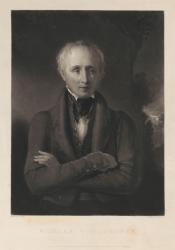The Life and Work of William Wordsworth
William Wordsworth (1770-1850) [Chapter 6, pg. 265] was a central figure in the English Romantic revolution in poetry. He was born in the Late District of northern England and received education in the classics at Hawkshead grammar school where he began writing poetry. His career really took off when he took his first trip to France and Switzerland during his last summer as an undergraduate. He formed an interest in politics and the natural world. In 1808, he moved to Rydal Mount, near Ambleside where he lived for the rest of his life.
He is known for poems such as “The Rime of the Ancient Mariner'' and “Tintern Abbey,” in which his goal was to “choose incidents and situations from common life to relate or describe them…in a selection of language really used by men” (Parrish). His poems and essays contributed a new view of the relation between man and nature and highlighted his own self-exploration. In Orlando, his name is mentioned when Orlando decides to start writing again. She said that her verse, “sullen and foreign looking, the snaky flower,” would no doubt be approved by Wordsworth. Perhaps she meant that the natural imagery of “snaky flower” related to Wordsworth’s own style and preference for nature.
In 1805, William’s brother, John, died. This event produced a new sobriety and restraint in Wordsworth’s poetry. By the mid-1830s, he had an established reputation by the critics and public. He was recognized in the 20th century as very important to the Romantic movement because of his appreciation for darker elements in his verse (Parrish). (262 word count)
Parrish, Stephen Maxfield. “The Recluse and the Prelude.” Encyclopædia Britannica, Encyclopædia Britannica, Inc., 2022, https://www.britannica.com/biography/William-Wordsworth/The-Recluse-and-...
Woolf, Virginia. Orlando. Mariner Books, 1956.

